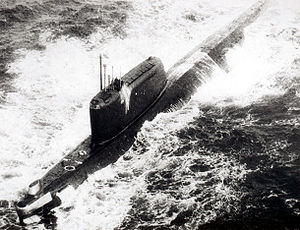
 Hotel II-class submarine
| |
| Class overview | |
|---|---|
| Name | Hotel class |
| Builders | Severodvinsk |
| Operators | |
| Preceded by | Golf class |
| Succeeded by | Yankee class |
| In commission | 1960–1991 |
| Completed | 8 |
| Retired | 8 |
| General characteristics | |
| Type | Nuclear submarine |
| Displacement | Hotel II class : 5,500 long tons (5,588 t) submerged [citation needed] |
| Length | 114 m (374 ft 0 in) |
| Beam | 9.2 m (30 ft 2 in) |
| Draught | 7.31 m (24 ft 0 in) |
| Propulsion | 2 × pressurized water reactors, 2 shafts |
| Speed |
|
| Complement | 104 |
| Armament |
|
The Hotel class is the general NATO classification for a type of nuclear-powered ballistic missile submarine that was launched by the Soviet Union around 1959. The Soviet designation was Project 658.
Design
[edit]The development of the submarine, designed to carry the D-2 launch system and R-13 missiles, was approved on 26 August 1956. Work on the design began in September 1956, the technical project was completed in the first quarter of 1957.[citation needed]
The duties of the chief designer of Project 658 were originally assigned to the chief engineer of OKB-18, P.Z. Golosovskiy. In February 1958 project management was transferred to I.V. Mikhaylov, who in October 1958 had replaced S.N. Kovalev. From the outset the deputy of the chief designer was I.D. Spasskiy.[1]
The Hotel design was based on the Project 627 November-class submarine,[2] the first Soviet nuclear submarines. They were modified by adding the missile compartment from the Golf-class submarines. Additionally, the Hotels had small horizontal hydroplanes for better maneuverability and more reliable electro-hydraulic command control surfaces for high-speed underwater operations with reduced noise.
The D-2 launch system on the Hotels placed three R-13 missiles in vertical containers directly behind the sail. The submarine had to be surfaced to launch, but all three missiles could be fired within 12 minutes of surfacing.[citation needed]
Variants
[edit]Hotel I
[edit]The first Hotel-class submarine, K-19, was laid down on 17 October 1958 and commissioned on 12 November 1960, only to suffer numerous setbacks and accidents. The last of the eight Hotel submarines was launched on April 1, 1962. All of them were built at Severodvinsk State Shipyard 402 (now known as the Northern Machine-Building Enterprise - SEVMASH) in Molotovsk (now Severodvinsk) shipyard[3] Russia.
Hotel II
[edit]Beginning in 1961 and ending in 1963, all Hotels but one (K-145) were equipped with the new D-4 launch system, which could launch missiles from a depth of 16 m (52 ft). The modified submarines received the NATO reporting name Hotel II. They were armed with R-21 (SS-N-5 Serb) missiles, with a range of 1,200 km (650 nmi).[4][5] The installation of the D-4 launching system required some structural changes of the submarine; before launch, the launch tube had to be flooded. The chief designer of the modification was S.N. Kovalev.
Hotel III
[edit]From 1969 to 1970, K-145 was modified by Project 701 to test the R-29 missiles, receiving the NATO reporting name Hotel III. It was lengthened to 130 meters and its displacement increased to 5,500 tons surfaced and 6,400 tons submerged. The maximum speed was reduced to 18 kn (33 km/h; 21 mph) on the surface and 22 kn (41 km/h; 25 mph) submerged. Six launchers for R-29 missiles were placed in two compartments, each with three launchers. In 1976 K-145 returned to combat service.[4]
Vessels
[edit]| # | Shipyard | Laid down | Launched | Commissioned | Status |
|---|---|---|---|---|---|
| K-19 | SEVMASH, Severodvinsk | 17 October 1958 | 11 October 1959 | 12 November 1960[4] | Decommissioned in 1991 as KS-19 for scrap |
| K-33/K-54 | 9 February 1959 | 6 August 1960 | 24 December 1960[4] | Decommissioned in 1987 for scrap | |
| K-55 | 5 August 1959 | 18 September 1960 | 27 December 1960[4] | Decommissioned in 1989 for scrap | |
| K-40 | 6 December 1959 | 18 June 1961 | 27 December 1961[4] | Decommissioned in 1987 for scrap | |
| K-16 | 5 May 1960 | 31 July 1961 | 28 December 1961[4] | Decommissioned in 1987 for scrap | |
| K-145 | 21 January 1961 | 30 May 1962 | 31 October 1962[4] | Decommissioned in 1989 for scrap | |
| K-149 | 12 April 1961 | 20 July 1962 | 27 October 1962[4] | Decommissioned in 1991 for scrap | |
| K-178 | 11 September 1961 | 1 April 1962 | 8 December 1962[4] | Decommissioned in 1990 for scrap |
Notes
[edit]- ^ "658 HOTEL I / II / III- Russian and Soviet Nuclear Forces". nuke.fas.org. Retrieved 2022-06-12.
- ^ "658 HOTEL I/II/III". Federation of American Scientists. Retrieved 28 May 2016.
- ^ Hotel Class Submarines
- ^ a b c d e f g h i j Podvodnye Lodki Rossii, Atomnye Pervoye Pokoleniye; Tom IV, Chast 1;1st Defense Ministry Scientific-Research Institute & Rubin Central Design Bureau of Marine Equipment; Sankt peterburg, 1996
- ^ Jackson, Robert (2000), Submarines of the World, Friedman/Fairfax Books, ISBN 1-58663-294-9, OCLC 48261790
References
[edit]- Page in Russian Language Archived 2008-01-21 at the Wayback Machine
- Page in English from FAS
- Hotel Class Submarines - Complete Ship List (English)
- The Encyclopedia Of Warships, From World War Two To The Present Day, General Editor Robert Jackson.